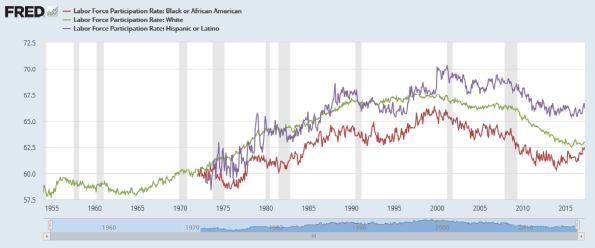Anic rate First: the elephant in the room: the post 2008 development of the USA white employment rate relative to the black and hispanic rate is, in a historical perspective but also when compared with post 2008 developments in Europe, spectacular. though something seems to have been the matter since 1995. No explanation here but the correlation between the white and the other rates slowly fades away (a hypothesis might be that ‘Blacks’ and ‘Hispanics’ are groups which are characterized by a relatively large subgroup of people belonging to the ‘precariat’, workers depending on low paid unstable jobs, who do relatively better in an increasingly precarious economy). Second: it’s not inconceivable that the black rate will, within years, also be at par with or higher than the white rate. Note that the decline of white employment in the 2008 crisis was much larger than during other downturns. This pattern is less outspoken for the hispanic and black employment rates. Next to the employment rate we can also look at the participation rate (unemployment plus employment). As black unemployment is higher than white unemployment, the black participation rate is, relatively, higher than the black employment rate. It might be at par with the white rate within months, reversing relative declines in the seventies and eighties of the twentieth centuries.
Topics:
Merijn T. Knibbe considers the following as important: Uncategorized
This could be interesting, too:
tom writes The Ukraine war and Europe’s deepening march of folly
Stavros Mavroudeas writes CfP of Marxist Macroeconomic Modelling workgroup – 18th WAPE Forum, Istanbul August 6-8, 2025
Lars Pålsson Syll writes The pretence-of-knowledge syndrome
Dean Baker writes Crypto and Donald Trump’s strategic baseball card reserve
anic rate 
First: the elephant in the room: the post 2008 development of the USA white employment rate relative to the black and hispanic rate is, in a historical perspective but also when compared with post 2008 developments in Europe, spectacular. though something seems to have been the matter since 1995. No explanation here but the correlation between the white and the other rates slowly fades away (a hypothesis might be that ‘Blacks’ and ‘Hispanics’ are groups which are characterized by a relatively large subgroup of people belonging to the ‘precariat’, workers depending on low paid unstable jobs, who do relatively better in an increasingly precarious economy).
Second: it’s not inconceivable that the black rate will, within years, also be at par with or higher than the white rate. Note that the decline of white employment in the 2008 crisis was much larger than during other downturns. This pattern is less outspoken for the hispanic and black employment rates. Next to the employment rate we can also look at the participation rate (unemployment plus employment).

As black unemployment is higher than white unemployment, the black participation rate is, relatively, higher than the black employment rate. It might be at par with the white rate within months, reversing relative declines in the seventies and eighties of the twentieth centuries. A worrying sign is the fact that the lackluster development of the USA employment and participation rates is not just a post 2008 event; it was also characteristic of the ‘recovery’ after the dotcom bubble. Note that after 2008 the white participation rate declines for a longer time than the black and hispanic one. Trump, anybody?
